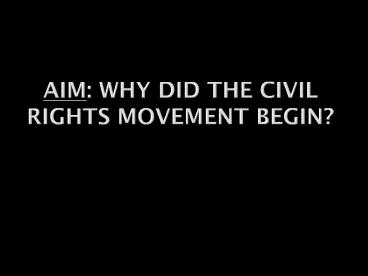Aim: Why did the Civil Rights movement begin? - PowerPoint PPT Presentation
1 / 21
Title:
Aim: Why did the Civil Rights movement begin?
Description:
Black athletes like Josh Gibson and Satchel Paige were interested in playing in the white only major leagues, but were unable to due to segregation. – PowerPoint PPT presentation
Number of Views:111
Avg rating:3.0/5.0
Title: Aim: Why did the Civil Rights movement begin?
1
Aim Why did the Civil Rights movement begin?
2
Objective
- Student will be able to name the major civil
rights legislation of the late 1940s and 1950s.
3
5. A New Beginning in Civil Rights
- The 1950s marked a new beginning in civil rights.
- During WW2, whites and blacks worked together to
defeat the Germans and Japanese. - On the battlefront and now at home, there was a
more tolerant attitude in the United States. - Now that the war was over, Blacks began to
organize and demand their civil rights.
4
5.1 The Truman Administration
- The Truman administration took steps to end
racial discrimination in the United States. - In 1946, Truman appointed a Commission on Civil
Rights. The commission stated that the government
should enforce civil rights and end segregation
in all areas of American life. - Although Congress failed to act on the commission
report, Truman then ordered desegregation in the
armed forces. - This was the start of desegregation on the
federal level.
5
Question 1
- When did desegregation begin?
6
- On the private level, there were signs that
Blacks were slowly gaining civil rights. - Black athletes like Josh Gibson and Satchel Paige
were interested in playing in the white only
major leagues, but were unable to due to
segregation. - In 1947, Jackie Robinson became the first Black
to break Major League Baseballs color line. Two
years later, Robinson won the MVP
Satchel Paige
Josh Gibson
7
Jackie Robinson
The first African-American to break Major League
Baseballs color barrier. Robinson broke the
color barrier on April 15, 1947. Enduring harsh
racial discrimination, Robinson built himself
into a solid baseball player on and off the
field. In 1997, to honor the 50th anniversary
of Robinsons achievement, Major League Baseball
retired the number 42.
8
5.2 The Eisenhower Years
- During the administration of Dwight Eisenhower,
some headway was made in regards to civil rights. - Eisenhower, at first, tried to stay away from
addressing the issue because he was not a strong
supporter of civil rights. - Eisenhower also believed that the job of
government was to not change peoples mind about
civil rights. - However, he was in charge of the US just as
things became interesting.
9
- In 1954, the United States Supreme Court ruled on
the case of Brown v. Board of Education of
Topeka. - In this ruling, the United States Supreme Court
overturned the separate but equal principle of
the Plessy v. Ferguson case (1896). - The Court held that segregation in the public
schools denied Black students equal protection
under the 14th Amendment.
10
Question 2
- What did the United States say about segregation
in the American public school system?
11
The Brown Case (1954)
The US Supreme Court integrates the American
public school system in 1954.
12
Two Key Figures in the Brown Case
Chief Justice Earl Warren, a strong supporter
of civil rights, was appointed by President
Dwight Eisenhower in 1953. He wrote the majority
decision in the case.
Thurgood Marshall was the lawyer that
defended Brown in her case. He would go on and
become the first African- American to be
appointed to the United States Supreme Court.
13
- In 1955, the Supreme Court ordered the
desegregation of the public schools. - In the south, this decision was not welcomed by
many leaders because the schools in the south
were segregated by law. Many leaders did whatever
they could to prevent this from occurring. - In 1957, Governor Orval E. Faubus of Arkansas
used the National Guard to keep Black students
from entering Little Rocks Central High School. - President Eisenhower used the military to allow
Blacks to enter Central High School. - By the end of his first term in office,
Eisenhower backed the decision of the Supreme
Court and enforced the decision to desegregate
the American public school system.
14
Question 3
- How did Southern leaders try to prevent
desegregation in their schools? What did
Eisenhower do to prevent this from happening?
15
Central High School-Little Rock, Arkansas (1957)
Governor Orval Faubus. His actions led
Eisenhower to bring the military into Little Rock.
The Little Rock Nine, the First Black students
who entered Central High School in 1957.
16
- Congress also acted to secure equal rights for
Blacks during this period of time. - To end restrictions on voting, the US Congress
passed the Civil Rights Acts of 1957 and 1960. - The Civil Rights Act of 1957 allowed the Attorney
General to bring suit for Blacks who were denied
their right to vote. - The Civil Rights Act of 1960 allowed Federal
judges to appoint an officer to supervise voter
registration. - The Civil Rights Act of 1960 also set punishments
for bombings and bomb threats against Blacks.
17
Question 4
- What did the Civil Rights Acts of 1957 and 1960
permit?
18
- Some Blacks turned to more direct action in the
hopes of achieving civil rights during the 1950s. - On December 1, 1955, in Montgomery, Alabama, Rosa
Parks refused to give up her seat on a bus to a
white male. She was arrested soon after. - In protest, Montgomery African-American leaders
E.D. Nixon and Martin Luther King boycotted the
bus system for a year. - The United States Supreme Court soon declared the
seating system in the Montgomery bus lines were
unconstitutional.
19
Rosa Parks
20
Montgomery Bus Boycott
21
Martin Luther King































